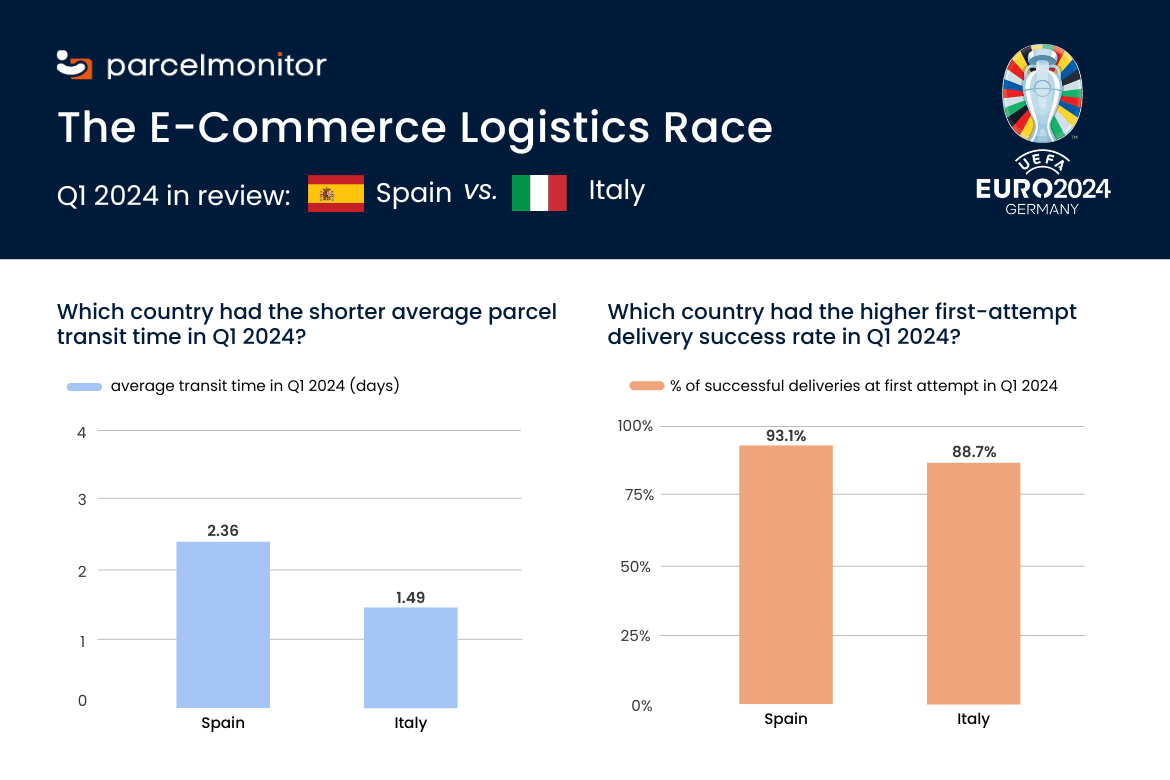Parcel monitor: E-commerce logistics race 2024: Spain vs. Italy
Written by
Editorial TeamPublished on
Discover the intense competition between Spain and Italy in the e-commerce logistics arena for 2024! From rapid transit times to high on-time delivery rates, explore how these top European markets are striving to deliver excellence in the latest Parcel Monitor article. (Ad)

(Image Source: Parcel Monitor)
Commercial collaboration
Now that Spain and Italy have played their highly anticipated UEFA 2024 match, all eyes are on e-commerce logistics, another competitive field in which these two countries are fighting for supremacy.
Italy and Spain both rank among the top five strongest e-commerce marketplaces in Europe, according to research by Direct Link. With prominent participants in the European e-commerce markets such as Yoox, Zara, El Corte Inglés, IBS, Saldiprivati, and Mango, these two nations have made a name for themselves.
E-commerce logistics businesses in Italy and Spain put in a lot of effort in the first quarter of 2024 to provide top-notch customer experiences. However, how did the logistics performance of these two countries compare? This article, which is part of Parcel Monitor’s E-Commerce Logistics Race series, focuses on Spain and Italy’s performance in the first quarter of 2024 and analyzes their advantages, shortcomings, and the reasons for their difficulties and triumphs.
Italy Outperformed Spain in Transit Time

(Image Source: Unsplash)
Quicker transit times are still essential for businesses to be competitive in e-commerce. For domestic e-commerce deliveries in Q1 2024, Italy had a remarkably short average transit time of just 1.49 days, far less than Spain’s 2.36 days. Improved distribution networks, well-placed warehouses, and effective transportation systems are only a few of the contributing factors to this outstanding achievement.
Notably, the infrastructure for transportation in Italy is highly developed. The national logistics infrastructure, which will serve as an important link between Eastern and Western Europe, has just received €750 million in funding for expansion, modernization, and maintenance. Similarly, an additional €500 million investment has been secured to promote sustainable rail travel throughout Italy.
One further factor that accounts for Italy’s quicker transit times compared to Spain is that Italian logistics providers used effective transportation routes—a dense network of highways and railways—to cut down on delays and guarantee on-time delivery. Furthermore, modern technology like real-time tracking has been adopted by e-commerce logistics businesses all throughout Italy, which may have streamlined operations and minimized possible problems.
Additionally, a number of strategically placed collection points and fulfillment centers run by several companies, including Amazon (13), WAPI (11), and others, are situated in Italy’s major population centers. These fulfillment centers facilitate the efficient movement of items from warehouses to customers’ doorsteps while meeting the demands of logistics and e-commerce.
Spain Had a Higher Rate of On-Time Delivery

(Image Source: Unsplash)
Even though Italy dominated in transit time, Spain excelled in on-time delivery performance, with an amazing 98.3% on-time delivery ratio in the first quarter of 2024. This metric demonstrates Spain’s capacity to regularly fulfill delivery timeframes, which builds end-user confidence and satisfaction. In contrast, Italy’s Q1 2024 on-time delivery percentage was 96.6%.
Spanish consumers are becoming more and more interested in choices with speedier delivery. They are willing to pay an additional €6.5 on average per order for faster shipping alternatives. According to research conducted by IAB Spain, 58% of Spanish customers anticipate receiving their online orders in three days or less. Additionally, 25% of Spanish customers indicated they would be willing to pay extra for same-day delivery. The development of e-commerce behemoths like Amazon, which have raised the bar for quick and reliable delivery, is contributing to Spain’s tendency for rapid delivery.
Many additional factors are also responsible for Spain’s remarkable on-time delivery performance. First and foremost, effective supply chain management practices have been crucial. Spanish logistics businesses are very skilled at keeping things running smoothly and effectively by carefully allocating resources and making comprehensive strategies.
Having effective communication with customers has also been essential. SMS texting and other forms of communication have been used by Spanish logistics businesses to update customers on the status of their deliveries. By swiftly resolving any delays or disruptions, this proactive strategy has helped control delivery expectations and reduce discontent.
To satisfy the needs of the expanding e-commerce industry, logistics providers in Spain have also reportedly used sophisticated techniques, such as improved strategic planning and forecasting, according to recent research. These providers are better able to allocate resources and improve delivery routes through the use of various technological solutions by predicting and planning for changes in order quantities. The high rate of on-time deliveries in Spain is a result of this optimization, which also lowers possible obstacles and guarantees prompt delivery.
Spain Recorded a Greater Success Ratio for First-Attempt Delivery

(Image Source: Pexels)
In order to guarantee satisfied customers and cut down on the expenses related to redelivery efforts, e-commerce businesses must prioritize first-attempt deliveries. Spain proved they were the best in this regard with a first-attempt delivery success rate of 93.1% in Q1 2024, outperforming Italy’s 88.7%.
A number of factors, such as precise address data, effective route planning, and skilled delivery staff, may have contributed to Spain’s better performance. The address format in Spain is fairly organized and includes the name of the receiver, the street name, the building (or apartment) number, the postal code, the town name, and the province. Thanks to these, delivery staff will find it easier to find the recipient’s address. Address data are also often verified and cleaned in Spain to guarantee correct delivery information.
What’s more, this metric may have been influenced by the disparities in the social and work cultures of the two countries. Following the COVID-19 outbreak, work-from-home policies and flexible work hours have grown increasingly popular in Spain. Research by Adigital, the Spanish Association of Digital Economy, found that 77% of Spanish customers prefer home delivery, with pickup locations and lockers coming in second at 14% and alternative choices like click and collect or delivery to the office coming in third at 9%.

(Image Source: Unsplash)
On the other hand, Italy’s first-attempt delivery success rate of 88.7% in the same period may have been attributed to the country’s active social life and traditional workplace culture, which places a higher value on in-person office attendance. According to research, Italy was found to be among the nations with the fewest remote workers. What’s more, parcel delivery services like BRT Bartolini and Poste Italine face substantial challenges because of restricted parking availability and traffic congestion in major Italian cities like Rome and Milan. These issues might cause deliveries to be delayed or result in unsuccessful first attempts.
Check out the full article here for even more insights!
_________________________________________________________________________________________
About Parcel Monitor
Your gateway to real e-commerce logistics data worldwide.
Parcel Monitor is the trusted source of e-commerce logistics insights – powered by real consumers’ order data. With a global network spanning over 1078+ carriers, 170+ countries and 60,000+ shipping routes, Parcel Monitor provides an accurate reflection of the e-commerce industry by tracking millions of parcels daily.
Parcel Monitor is recognized as a reputable data source within the global logistics sector, endorsed by prominent publications like The Washington Post and The New York Times and . frequently collaborates with industry leaders such as Rakuten Insights, CBRE, Transport Intelligence, and eMarketer.
***

![Marketing in Europe in 2026: What's new and what hasn't changed? [McKinsey Report]](https://ecommercegermany.com/wp-content/uploads/2026/01/windows-w79mIrYKcK4-unsplash-720x480.jpg)
